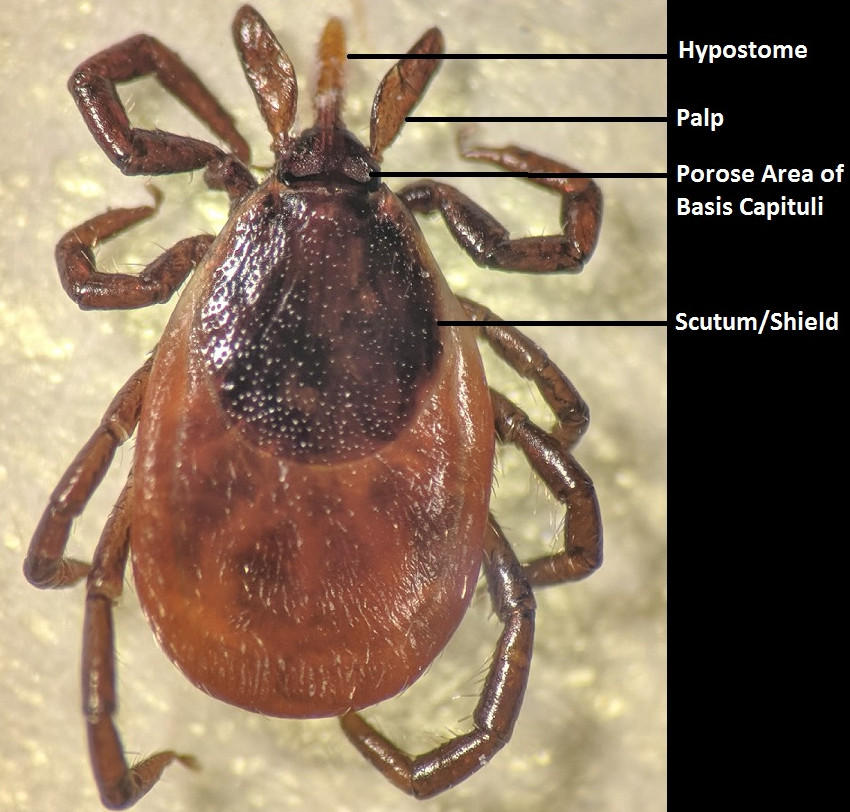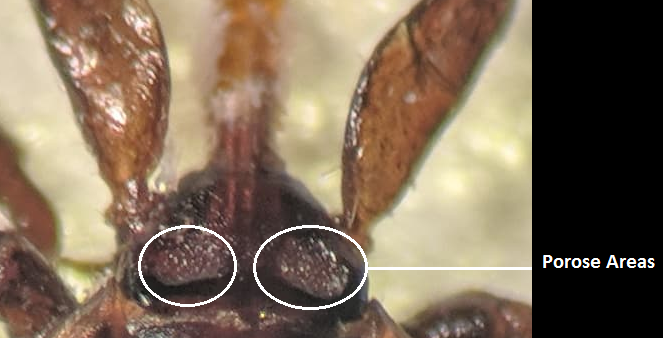Anatomy of a Female Deer Tick
Dorsal View

Hypostome
Barbed mouthpart injected into host to suck blood. Adult males will use the hypostome to fertilize adult females.
Palp
Used to detect a nearby host.
Porose area of Basis Capituli
Used as an identifying characteristic to determine tick species. Adult female deer ticks will have smaller porose areas than other tick species.
Scutum/Shield
Used as an identifying characteristic to determine tick life stage, species, and sex. Only nymph and adult female deer ticks will have shield located on the top portion of the back. Deer ticks have black, oblong shields.
Ventral View

Hypostome
Barbed mouthpart injected into host to suck blood. Adult males will use the hypostome to fertilize adult females.
Palp
Used to detect a nearby host.
Trochanter
Part of the leg that attaches to the coxa. Deer ticks will have trochanters without spurs. This characteristic can be useful in identifying tick species.
Basis Capituli
Attaches the mouthparts to the body. The basis capituli of a deer ticks will be straight at the bottom where it connects to the body and will be missing rounded humps on the top on either side of the hypostome. These characteristics are used in identifying the species.
Coxa I-IV
Attach the trochanter of the leg to the body of the tick.
Genital Aperture
Where the adult male tick will insert his hypostome to mate and fertilize the adult female tick.
Spiracular Plate
Has glands that may be involved in regulation of water loss and air diffusion. Used as an identifying characteristic to determine tick species.
Anal Groove
Used to identify species of tick. Deer ticks (Ixodes scapularis) will have an anal groove that extends above the anus while other species of tick not in the genus Ixodes will have an anal groove that stays below the anus.
Actual Size of the Adult Female and Nymph Deer Ticks

The adult female deer tick (left) is about .40cm long when measured from the tip of the mouthparts to the bottom of the abdomen. The nymph deer tick (right) is about .15cm long when measured from the tip of the mouthparts to the bottom of the abdomen.
Adult Female Deer Tick Engorgement

Identifying Characteristics of an Adult Female Deer Tick
Contents
- Examining the Hypostome and Palps
- Examining the Basis Capituli
- Examining the Coxa and Trochanters of the Legs
- Examining the Scutum/Shield
When we receive a tick in the lab, the first thing we do is analyze it under a microscope. Using characteristics specific to the deer tick we can identify the species.
1. Examining the Hypostome and Palps
The palps of a deer tick are long and the hypostome has 4 rows of teeth-like projections on each side.
- Denticle
- Small, tooth-like projection; Individual, recurved teeth on the ventral side of the hypostome. Usually arranged in parallel, longitudinal rows or files.
- Hypostomal Dentition
- Arrangement or number of files of denticles on either side of the middle line of the hypostome.
Determining Hypostomal Dentition:
- View hypostome under microscope
- Count rows/files of denticles on either side of the middle line (See example below)


2. Examining the Basis Capituli
The basis capituli connects the mouth parts (hypostome and palps) to the body. When identifying a deer tick we look for a basis capituli that has a nearly straight bottom and is missing rounded humps on either side of the palp. We also look for small porose areas.


3. Examining the Coxa and Trochanters of the Legs
The coxa is the part of the tick that connects the leg to the body. Ticks have four coxae and four legs. Deer ticks will have a spur on the first coxa (coxa I) that is not too long or short. They will also have smaller spurs on the 2nd, 3rd, and 4th coxa.
The trochanter is the part of the leg that connects to the coxa and body of the tick. Ticks have one trochanter per leg. Adult female deer ticks will be missing a spur on their trochanters.



4. Examining the Scutum/Shield
The scutum/shield rounded, not roughened and is smooth with very small punctations (spots).

